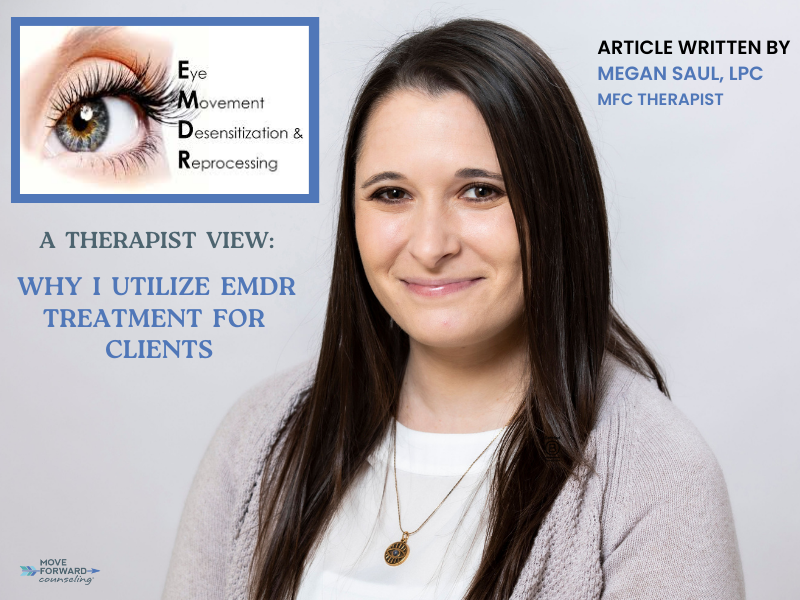A Therapist View: Why I Utilize EMDR Treatment for Clients
(Eye Movement Desensitization and Reprocessing)
Written by Megan Saul, LPC, and EMDR Technique Trained Move Forward Counseling Therapist
Discovering EMDR
The first time I remember hearing about EMDR was in graduate school. Even then, I struggled to understand its concept and wasn’t aware of anyone practicing with it. It was very different from other evidence-based theories being taught. It was only when I became certified in EMDR that I understood its practicality and usefulness. I realized this wasn’t just unique but very effective in treating those suffering from trauma.
I could see this from the research (which can be found on emdr.com and emdria.org) and from the utilization in my own practice. I had been treating clients with trauma for almost five years, and most of that time, my treatment consisted of talk therapy. Now, when working with clients who identify as struggling with trauma, I introduce and encourage them to think about EMDR.
EMDR Beginnings
Since 1989, EMDR, or Eye Movement Desensitization and Reprocessing, has been extensively researched and published, showing evidence of its effectiveness in treating PTSD, with other studies showing positive results in its usage for other diagnoses (I.e., anxiety, addiction, and depression). Dr. Francine Shapiro first discovered it in 1987 after she had taken a walk to clear her head. She noticed that disturbing thoughts had disappeared, and upon further consideration, found that “when disturbing thoughts came into my mind, my eyes spontaneously started moving very rapidly back and forth in an upward diagonal” (Shapiro, 2018, p. 7). Shapiro continued working on her disturbing thoughts, developing different eye movements and techniques. They were first used on herself and later colleagues and friends to develop the practice. Over time, her research found marked changes in lower anxiety and positive cognitive changes in clinical trials with those who were given EMDR as a treatment as opposed to those who were not.
How EMDR Works
The way I explain this to my clients is that it treats trauma differently. Instead of traditional talk therapy, EMDR focuses on where trauma is stored and helps the client unlock this. Shapiro believes there is a memory network that EMDR could help access. Through that, the client could process old information and potentially forge new adaptive memories and perspectives. This allows the client to have more complete information processing, more cognitive insight, less emotional distress, and new learning, all of which result in the clients acquiring more skills for better adaptive functioning. In other words, it helps clients “heal from the symptoms and emotional distress that result from disturbing life experiences” (emdr.com, 2020).
Managing Trauma with EMDR
Since practicing with EMDR I have mainly used this with clients suffering from PTSD. I have evaluated clients with almost 10 years of dealing with a traumatic event begin living their lives in a way they never thought they could using the treatment. Several have noted that if the memory pops up its much easier for them to just push the thought away using these techniques. They express feeling less controlled by their trauma and the ability to be present after completing all stages of an EMDR treatment. They have talked about learning something new about themselves through this process and coming out of it stronger and more capable than before.
Sources:
Shapiro, F. (2018). Chapter 1. In Eye movement desensitization and reprocessing (EMDR) therapy: Basic principles, protocols, and procedures (Third, p. 7). essay, The Guilford Press.
What is EMDR. EMDR. (2020). Retrieved January 24, 2023, from www.emdr.com.
You can learn more about the author and mental health therapist, Megan Saul, who has availability for appointments with new clients online from anywhere in Pennsylvania.




























